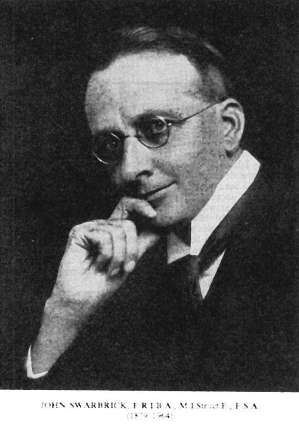John Swarbrick
- Birth date: 22 May 1879 at Burnage, Manchester
- Marriage Jan-March 1926 to Beatrice Emily Neill at Conway district
- Death date 19 October 1964 at 14 Whitehall Road Rhos-on-Sea.
- Burial Southern Cemetery Manchester
Born in 1879 at Burnage, Manchester, John Swarbrick was the only child of Alderman Joseph Swarbrick FRIBA and Sarah Holt (nee Philips). His father was a surveyor and civil engineer who later trained as an architect. Much involved in local politics, Joseph became a local councillor for Withington UDC and Alderman of Manchester City Council. The family attended Withington Congregational Church and included in their circle the antiquarians Fletcher Moss and James Watt junior.
John Swarbrick was privately educated, and was articled to his father in 1897 while studying at Owen’s College, Manchester and the Architectural Association and the Royal Academy Schools (1902-1907) in London. He also records visits to France, Holland Belgium Switzerland and Italy although few details are known. Having passed the RIBA qualifying examination, he was elected Associate of the Royal Institute of British Architects in December 1902. In 1904 Joseph Swarbrick took him into partnership under the style “Joseph Swarbrick and Son.” After his father’s death in 1928, he continued the practice alone.
Although his later antiquarian interests were mostly confined to the mediaeval period, his scholarly reputation was based upon his study of Robert Adam. At the Architectural Association he won a prize for a substantial essay on Adam in 1903, serialised in five issues of the Association’s Notes. However, it was not until 1915 that Batsford published it in book form under the title “Robert Adam and His Brothers: their lives, work and influence on English architecture, decoration and furniture. ”
John Swarbrick’s known architectural commissions are mostly confined to the pre-war period; only Yester Lodge Bramhall and the Congregational Church, Parrs Wood Road have been identified as dating from the inter-war period. In this early period the practice also entered numerous competitions, seemingly without success. Following the end of the First World War, John Swarbrick’s interests moved to old buildings and their preservation. In 1921 he researched Hough End Hall as preparation for [preparing] a scheme to show how the hall and its setting might be preserved if a proposed road was diverted. What began as the rescue of one building rapidly became a more general campaign and in 1923 Swarbrick determined that a new Society was necessary - the Ancient Monuments Society, formally constituted at John Rylands Library, Manchester on 2 June 1924. From this date the AMS was at the forefront of historic building preservation in North-West England. In 1926 he was supervising the treatment of death watch beetle infestation at Dunham Massey Hall and repairs to Warburton Old Church. He served as its honorary architect until his death in 1964 and was also a founder member of the Council for the Protection of Rural England.
In the mid-1920s he began his experiments in measuring daylight in buildings, culminating in the patenting of the Photo-theodolite in 1931. What inspired this interest is not known, but he soon became a recognised expert on ‘Rights of Light‘ and similar matters which may have occasioned his decision to move his operations to London. Later research into the use of light in architecture resulted in the publication of “Easements of Light” in 1929, and “Daylight: its Nature, Therapeutic Properties, Measurement and Legal Protection” in 1953. From 1930 Swarbrick spent an increasing amount of his time in London and by the end of the Second War held a government post with the Building Research Station.
Attempts to resurrect his career in the 1950s were unsuccessful and he eventually retired to Rhos-on-Sea, near Colwyn Bay, an area he had visited on holiday for at least sixty years. Little is yet known of his other activities in North Wales. In 1953 he published an article, “Conway,” in the Transactions: Ancient Monuments Society Volume 1. It would also seem that he carried out alterations to Gwydir Castle in the Conway Valley in the 1930s.
John Swarbrick died on 19 October 1964, aged 85, at Rhos-on-Sea. He was survived by his wife Beatrice Emily (1882-1981); there were no children. He is buried with his parents in Southern Cemetery, Manchester.
Address
1903 John Swarbrick ARIBA. 30, St Ann's Street Manchester
1913 John Swarbrick ARIBA. 30, St Ann's Street Manchester
1927 John Swarbrick FRIBA. 30, St Ann's Street Manchester
1932 John Swarbrick FRIBA 14, John Dalton Street & London office (MCN)
1936 Joseph Swarbrick & Son 66 Mosley Street Manchester (AJ 12 March 1936 Page 409)
1937 John Swarbrick FRIBA. (Joseph Swarbrick & Son) 66, Mosley Street Manchester
1929-35 John Swarbrick FRIBA (Joseph Swarbrick & Son) 39 Maddox Street London W1
1936- John Swarbrick FRIBA (Joseph Swarbrick & Son) 11 King’s Bench Walk, Temple, London EC4
1951-3 John Swarbrick FRIBA (Joseph Swarbrick & Son) Norton Chambers, 34 Great Ormond Street
Residence
1901 Dunluce, 24 Moorfield Road, Didsbury
1911 24 Moorfield Road, West Didsbury
1948 John Swarbrick FRIBA. FSA 52, Claygate Lane, Esher, Surrey
1955 John Swarbrick Applegarth 26 Sandy Lane, Cheam, Surrey
1964 "Hanlyn", 208 Dinerth Road, Rhos-on-Sea
Obituary LCAS Volume 73 Page 206
Obituary Builder v207, 23,30 October 1964, page 860, 935
Obituary Guardian Thursday 22 October 1964. Page 14
Reference Frank Kelsall, John Swarbrick, Architect and Antiquary, essay in Making Manchester, ed Clare Hartwell and Terry Wyke, 2007
Reference Works by John Swarbrick listed in his FRIBA nomination paper, 11 December 1918
Reference Manchester City News 25 July 1931
Reference Information from Richard Fletcher
